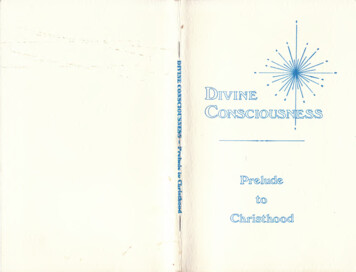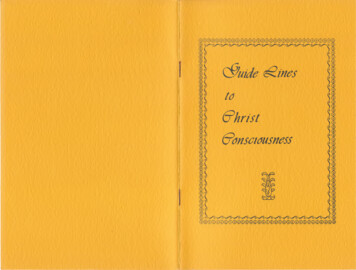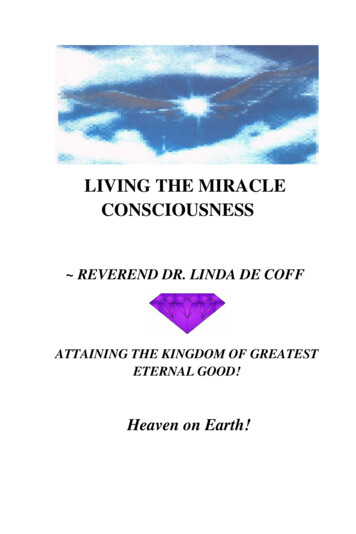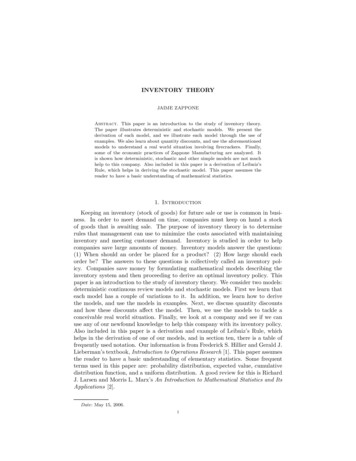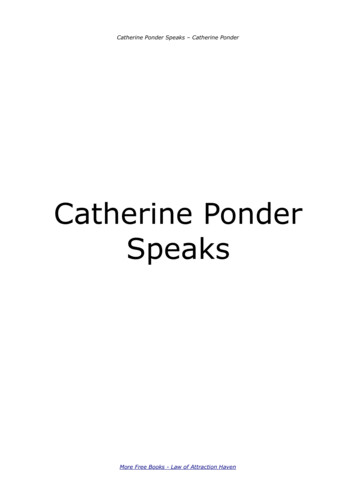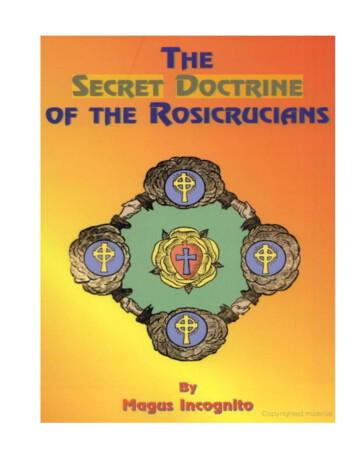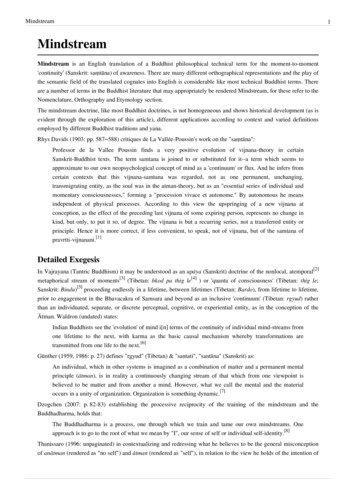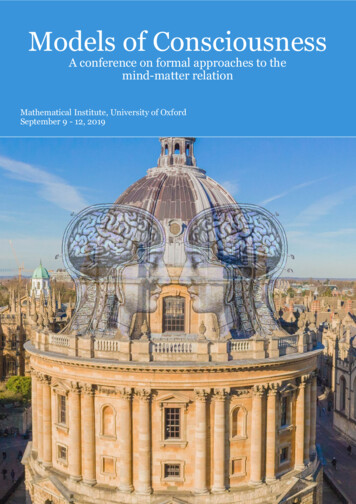
Transcription
1Models of ConsciousnessA conference on formal approaches to themind-matter relationMathematical Institute, University of OxfordSeptember 9 - 12, 2019
2Sponsors andorganising institutions
3PROGRAMMETable of ContentsWelcome 4The conference team 5Building plan 6Conference dinner at Somerville College 7Coffee, tea, lunch and drinks 7Area map and where to eat out 8Programme schedule 10Talk titles and abstracts 12Poster titles and abstracts 31Discussion sessions 36Conference publication details 37
4WelcomeConsciousness and its place in nature have collectively been one ofthe great mysteries of humanity and have served as the focus ofphilosophical and religious investigations for almost two millennia.Internationally the subject has generated sustained interest amongmathematicians, physicists, and others who aim to translate theresults of previous investigations into formal-mathematical models.This interest has been fuelled by the observation that many relevantquestions, e.g. about the connection between fundamental physicsand consciousness, are not amenable to less formal analysis. Todate, much of this work has been pursued in isolation and outside ofthe academic mainstream. The aim of this conference is to begin tochange that by fostering collaboration and the exchange of ideasbetween researchers interested in these ideas.Oxford was chosen as the site of what hopefully will be the first ofmany such conferences due to the idyllic intellectual and aestheticenvironment as well as the presence of the Oxford Mathematics ofConsciousness and Applications Network (OMCAN). The origin ofthe modern concept of consciousness is often attributed to JohnLocke’s Essay Concerning Human Understanding, published in1690. Locke was, himself, a graduate of Christ Church, Oxford.Locke defined consciousness as “the perception of what passes in aman’s own mind” and this definition was included in SamuelJohnson’s 1755 Dictionary.Johnson, himself, had attendedPembroke College, Oxford and was the recipient of a Master of Artsfrom the University. So it is appropriate to be returning to thishallowed ground to discuss and debate these issues.Welcome to Oxford!
5The conference teamOrganisers*Dr Johannes KleinerRobin LorenzDr Robert PrentnerInstitute for TheoreticalPhysicsLeibniz University ofHanoverGermanyDPhil studentDepartment of ComputerScienceUniversity of OxfordUKSociety for Mind-MatterResearchDepartment of CognitiveSciencesUniversity of CaliforniaIrvine USADr Jonathan MasonOxford Mathematics ofConsciousness andApplications Network(OMCAN)Prof. Yakov KremnitzerOxford Mathematics ofConsciousness andApplications Network(OMCAN)Mathematical InstituteMathematical InstituteUniversity of OxfordUKAdvisory boardProf. Ian DurhamDepartment of PhysicsSaint Anselm CollegeNH USAUniversity of OxfordUK*The advisory board gratefully acknowledges the work and effort of all theorganisers and gives particular thanks to Dr Kleiner who lead the work.
6Building planLecture theatre level& CaféMain conference location — L3Discussion sessions — L3, C5, C6
7Conference dinnerSomerville College (19:00 Wednesday 11th Sep)For those joining the conference dinneron Wednesday 11th September, the dinner is being held at Somerville CollegeOxford, just a short walk from the Mathematical Institute. The College is enteredthrough the Lodge House (pictured right)on the Woodstock Road. See the map onthe next page for the location.Coffee, tea, lunch and drinksThe Common roomCoffee and tea breaks will be held in the Common room on thefirst floor of the Mathematical Institute. Conference participantsmay need to show their conference badges to be allowed throughthe glass doors at the ground floor reception desk. The postersession and drinks receptions will also be held in the Commonroom.LunchConference participants are welcome to have lunch in the Mathematical Institute Café located on the same level as the lecturetheatres. Alternatively, there are many local pubs and restaurantswithin a few minutes walk of the Mathematical Institute alongWalton Street, and Little Clarendon Street; see the next page.
8Area mapEating and drink outRestaurants: Café in the Mathematical Institute The Pierre Victoire (FrenchCuisine) Will's Deli Branca (deli and restaurant) Opera Cafe Al-Shami (Lebanese/Syrian) Cafe RougePubs (typically good food too): The Royal Oak The Gardener's Arms onPlantation Road (good andexclusively vegetarian menu) Eagle and Child (for Toklien andC.S.Lewis fans) The Rose and Crown The Victoria The White Rabbit (they havevegan pizza) The Rickety Press The Jerico Tavern The Harcourt Arms The King's Arms
9
10Programme scheduleFrom 8:15MondayRegistration (outside L3)Tuesday08:45 - 09:00 Welcome (L3)09:00 - 10:00 Invited Talk (L3)1 William Marshall09:00 - 10:00 Invited Talk (L3)10 Peter Grindrod10:00 - 10:30 Coffee (Common room)10:00 - 10:30 Coffee (Common room)10:30 - 10:5510:55 - 11:2011:20 - 11:4511:45 - 12:4510:30 - 10:5510:55 - 11:2011:20 - 11:4511:45 - 12:452 Johannes Kleiner (L3)3 Adam Barrett4 Xerxes ArsiwallaDiscussion Session 1(L3, C5, C6)11 Pedro Resende (L3)12 Aaron Sloman13 Agne AlijauskaiteDiscussion Session 3(L3, C5, C6)12:45 - 14:00 Lunch12:45 - 14:00 Lunch14:00 - 15:00 Invited Talk (L3)5 Sir Roger Penrose14:00 - 15:00 Invited Talk (L3)14 Jonathan Mason15:00 - 15:25 6 Stuart Hameroff (L3)15:25 - 15:50 7 Sean Tull (L3)15:00 - 15:50 Invited Talk (L3)15 Tim Palmer15:50 - 16:10 Coffee (Common room)15:50 - 16:10 Coffee (Common room)16:10 - 16:35 8 Paul Skokowski (L3)16:35 - 17:00 9 Camilo Signorelli17:00 - 18:00 Discussion Session 2(L3, C5, C6)16:10 - 16:35 16 Peter Lloyd (L3)16:35 - 17:10 17 Ian Durham (L3)18:00 - 19:00 Joint Poster Session withDrinks (Common room)18:00 - 19:00 Evening Invited Talk (L3)18 Adrian Kent17:10 - 18:00 Drinks Reception withNibbles (Common room)19:00 - 20:00 Evening Discussion 4Sessions (L3, C5, C6)*The poster session is being jointly held with the Higher-order Interaction Networksconference.
11WednesdayThursday09:00 - 10:00 Invited Talk (L3)19 Yakov Kremnitzer09:00 - 10:00 Invited Talk (L3)28 Chetan Prakash10:00 - 10:30 Coffee (Common room)10:00 - 10:30 Coffee (Common room)10:30 - 10:5510:55 - 11:2011:20 - 11:4511:45 - 12:4510:30 - 10:5510:55 - 11:2011:20 - 11:4511:45 - 12:4520 Michael Silberstein (L3)21 Ramón Guevara Erra22 Anita MehtaDiscussion Session 5(L3, C5, C6)29 Aïda Elamrani (L3)30 Diana Stanciu31 Marc EbnerDiscussion Session 7(L3, C5, C6)12:45 - 14:00 Lunch12:45 - 14:00 Lunch14:00 - 14:50 Invited Talk (L3)23 Mauro D'Ariano14:00 - 14:2514:25 - 14:5014:50 - 15:1515:15 - 15:4014:50 - 15:15 24 Paul Baird (L3)15:15 - 15:40 25 Pierre Baudot32 Andrej Bicanski (L3)33 Gustav Bernroider34 Inês Hipólito35 Pedro Mediano15:40 - 16:10 Coffee (Common room)15:40 - 16:10 Coffee (Common room)16:10 - 16:35 26 Shanna Dobson (L3)16:35 - 17:00 27 Quanlong Wang17:00 - 18:00 Discussion Session 6(L3, C5, C6)16:10 - 16:35 36 Jeff Yoshimi (L3)16:35 - 17:00 37 John Barnden17:00 - 18:00 Closing DiscussionSession 8 (Plenary L3)18:00 - 19:0019:00 - lateDrinks Reception andConference Dinner(Somerville College)
12Talk titles and abstracts1 William Marshall (Invited)Department of Mathematics and Statistics, Brock UniversityIntegrated Information Theory: From Phenomenal to PhysicalThe dominant approach in consciousness science is to identify the neuralcorrelates of consciousness – neural activity which correlates with specificexperiences. However, many have argued that the subjective nature ofexperience makes it difficult (if not impossible) to distill consciousness fromneural activity (the so-called “hard problem”). Integrated information theorytakes a different approach, starting from consciousness itself to identify itsessential properties, and then postulating what sort of physical substrate couldsupport it.In this talk, I briefly review the phenomenal approach of IIT and themathematical framework that follows from it. I will then outline some of theexplanations, predictions, and inferences made by the theory. Finally, I willdiscuss new developments to the theory and how they can be used to explaincertain qualitative aspects of experience.2 Johannes KleinerInstitute for Theoretical Physics, Leibniz University of HannoverOn the Mathematical Basis of Models of ConsciousnessThe goal of this talk is to discuss the mathematical basis of models ofconsciousness, most notably the question of which mathematical structure oneis to use to describe experience in any formal theory. This question isinextricably linked with the conceptual basis of models of consciousness.After briefly reviewing the various choices made in existing models, I explainhow a systematic answer to this question can be constructed based on afurther development of the concepts introduced by Thomas Nagel and DavidChalmers. If time permits, I will outline how this leads to a full mathematicalframework for models of consciousness.3 Adam BarrettSackler Centre for Consciousness Science, University of Sussex, UKIntegrated information theory: a perspective on weak’ and strong’versionsIntegrated Information Theory (IIT) has gained a lot of attention for potentiallyexplaining, fundamentally, what is the physical substrate of consciousness. Thefoundational concepts behind IIT were extremely innovative, and it has beenvery exciting to see certain predictions being upheld in experiments. However,many problems have been uncovered with the mathematical formulae that IITproposes for measuring consciousness exactly. This has led to fragmentationamongst consciousness researchers, between those who accept IIT, and those
13who reject IIT.In this talk, I make the case for a weak’ form of IIT as a pillar of a future theoryof consciousness, and summarise some of the problems with strong’ IIT. WeakIIT maintains that neural correlates of consciousness must reflect two keyaspects of phenomenology. First, that each conscious moment is extremelyinformative (it is one of a vast repertoire of possible experiences). Second, thateach conscious experience is integrated (it is experienced as a coherentwhole). I review some of the empirical evidence for this, in the form of greaterdiversity and connectivity in observed neural dynamics from conscious versusunconscious humans. I then discuss how the Phi measure of integratedinformation is not well-defined, and not unique given the axioms of IIT, andhence that the current version of strong IIT should be rejected. I conclude withsome discussion on possible ways forward.4 Xerxes ArsiwallaInstitute for Bioengineering of Catalonia Barcelona, SpainComputing Meaning from Conceptual Structures in Integrated InformationTheoryTheories of consciousness such as Integrated Information Theory (IIT) and itsvarious approximations are grounded on intrinsic information and causaldynamics. However, what seems to be missing or at least is not explicitlyaddressed in this framework is the role of meaning. One could argue thatconscious experience not only generates information, but also meaning. Wepostulate that meaning associated to experience is intrinsically generated, iscompositional, specific and integrated. How can this be formalized within thecontext of IIT? Here we propose a framework for computing the compositionalmeaning of the maximally irreducible conceptual structure or Q-shape in IIT. AQ-shape is a set of concepts and their relations. To compute the meaning of aQ-shape we apply the category theoretic formulation of DistributionalSemantics, used in natural language processing. This assigns to every conceptin the Q-shape, a distributional meaning and a grammatical type. Byconsistency, concepts with very high phi (core concepts) will be the mostpertinent for the experience at that specific instance. The distributional meaningof each core concept depends on its relations to all other concepts in the Qshape and can be computed using a vector space spanned by a basis ofconcepts as is done in Distributional Semantics. The grammatical typesassociated to core concepts are constrained by their relations to other coreconcepts. Furthermore, a pre-group algebra imposes ordering of grammaticaltypes. We then show how the sub-network of core concepts in the Q-shape canbe identified with a category theoretic process diagram. The compositionalmeaning of this process diagram is computed within a monoidal category andyields the meaning associated to the experience. We demonstrate thiscomputation with a simple toy model. Finally, we comment on how meaningimposes phenomenologically relevant constraints to any information-basedtheory of consciousness.
145 Sir Roger Penrose (Invited)Mathematical Institute, University of OxfordAI, Consciousness, Computation, and Physical LawA common scientific view is that the actions of a human brain could, inprinciple, be simulated by appropriate computation, and even that it may not betoo far into the future before computers become so powerful that they will beable to exceed the mental capabilities of any human being. However, by usingexamples from chess and mathematics, I argue, that the quality of consciousunderstanding is something essentially distinct from computation.Nevertheless, I maintain that the action of a conscious brain is the product ofphysical laws, whence consciousness itself must result from physicalprocesses of some kind. Yet physical actions, over a huge range, can besimulated very precisely by computational techniques, as is exemplified by theLIGO gravitational wave detectors confirming precise calculations, withinEinstein’s general relativity theory, of signals from black-hole encounters indistant galaxies.Despite this, I argue that there is a profound gap in our understanding of howEinstein’s theory affects quantum systems, and that there is reason to believethat the events termed “collapse of the wave-function” take place objectively(gravitational OR), in a way that defies computation, yet should be observablein certain experiments. It is argued that each such event is accompanied by amoment of “proto-consciousness”, and that actual consciousness is the resultof vast numbers of such events, orchestrated in an appropriate way so as toprovide an actual conscious experience (Orch-OR).6 Stuart Hameroff (Invited)Center for Consciousness Studies, University of Arizona, Tucson, ArizonaAnesthetic action on quantum terahertz oscillations in microtubulessupports the Orch OR theory of consciousnessThe Penrose-Hameroff ‘Orchestrated objective reduction’ (‘Orch OR’) theorysuggests consciousness arises from ‘orchestrated’ quantum superpositionedoscillations in microtubules inside brain neurons. These evolve to reachthreshold for Penrose ‘objective reduction’ (‘OR’) by E h/t (E is the gravitationalself-energy of the superposition/separation, h is the Planck-Dirac constant, andt the time at which Orch OR occurs) to give moments of conscious experience.Sequences, interference and resonance of entangled moments governneurophysiology and provide our ‘stream’ of consciousness. Anesthetic gasesselectively block consciousness, sparing non-conscious brain activities, bindingby quantum coupling with aromatic amino acid rings inside brain proteins.Genomic, proteomic and optogenetic evidence indicate the microtubule proteintubulin as the site of anesthetic action. We (Craddock et al, Scientific Reports7,9877, 2017) modelled couplings among all 86 aromatic amino acid rings intubulin, and found a spectrum of terahertz (‘THz’) quantum oscillationsincluding a common mode peak at 613 THz. Simulated presence of 8 differentanesthetics each abolished the peak, and dampened the spectrum proportional
15to anesthetic potency. Non-anesthetic gases which bind in the same regions,but do not cause anesthesia, did not abolish or dampen the THz activity. OrchOR is better supported experimentally than any other theory of consciousness.7 Sean TullDepartment of Computer Science, University of OxfordGeneralised integrated information theoriesIntegrated Information Theory (IIT), developed by Giulio Tononi andcollaborators, has emerged as one of the leading scientific theories ofconsciousness. At the heart of IIT is an algorithm which, based on the level ofintegration of the internal causal relationships of a physical system in a givenstate, claims to determine the intensity and quality of its conscious experience.However, IIT is known to possess several technical problems, and is onlyapplicable to simple classical physical systems. To be treated as fundamental,it should ideally be extended to more general physical theories.In this work, we investigate the formal structure of IIT, and define a notion ofgeneralised integrated information theory in order to address these problems.Formally such a theory specifies a mapping from a given theory of physics toone of conscious experience, each satisfying minimal conditions needed for theIIT algorithm.In particular we show how a generalisation of IIT may be constructed from anysuitable physical process theory, as described mathematically by a symmetricmonoidal category. Specialising to classical processes yields IIT as usuallydefined, while restricting to quantum processes yields the recently proposedQuantum IIT of Zanardi et al. as a special case.8 Paul SkokowskiSymbolic Systems and Philosophy, Stanford University;St Edmund Hall, University of OxfordCausal constraints on models of consciousnessConscious experience is a phenomenon that each of us knows intimately well.The subjective characters of our sensations are immediately apparent to us.These subjective characters are qualia. Integrated Information Theory (Oizumi,Albantakis and Tononi 2014) is a model of consciousness which proposes thatqualia are solipsistic, self-generated, self-referential, and holistic. We comparethis view with causal constraints which apply in the natural world, and whichshape the intentional properties of the experiences of biological creatures likeus. A theory of physical detection is proposed to account for the contents ofconscious states, grounding qualia in a way that satisfies causal constraints inthe natural world.9 Camilo SignorelliDepartment of Computer Science, University of OxfordConsciousness interaction, from experiments to a multi-layer modelEmpirical evidence regarding neural studies of consciousness and conscious
16perception is mainly unknown in fields such as physics and mathematics, orsometimes even misunderstood by many scientists inside the own field ofconsciousness research. A critical survey of these experiments revealsdifferent aspects and dynamical features among distinct processes related tothe conscious phenomenon. These features and distinctions need to beincorporated in any attempt of modelling consciousness and the study ofmathematical structures of consciousness. Therefore, part of that evidence isfirst reviewed to later generate a preliminary multi-layer model calledConsciousness interaction, suitable for further mathematical generalization. Inthis “prototype” of theory, biological and cellular principles together withmathematical structures are fundamental ingredients and importantcomplement for current physical descriptions such as dynamical systems,emergent, and sub-emergent properties. One advantage of the mentionedapproach is the potential of reducing the apparent number of theories ofconsciousness to a few models, without the need for a single experiment.Moreover, new insights and empirical predictions are expected after thistheoretical exercise, eventually producing a list of few experimental tests toverify or falsify current and future models of consciousness.10 Peter Grindrod (Invited) - joint research with Christopher LesterMathematical Institute, University of OxfordLarge scale simulations of information processing within the humancortex: what “inner life” occurs?We seek to model the human cortex with 1B to 10B neurones arranged in adirected and highly modular network (a network of networks); with the tightlycoupled modules (each containing 10,000 neurones or so) representing thecortical “columns”. Each neurone has an excitable and refectory dynamic andthe neurone-to-neurone connections incur individual time delays. Thus thewhole is a massive set of modular delay-differential equations (expensive tosolve on a binary computer, but easily implemented within 1.5kg of neural wetware). Our early work has shown why evolution has resulted in such a designto ensure optimal use of the limited space and energy available. Indeed we canshow that if the time delays were all integers rather than reals then much of thepotential behaviour (dynamical degrees of freedom) would be lost.Simulating a 1B neurone directed graph produces its own big data challenge.We focus on the inner life of these complex dynamical system, and show thatthe dynamical responses to external stimuli result in distinct, latent (internal),dynamic “states" or modes. These inner subjective and private states governthe immediate dynamical responses to further incoming stimuli. Hence they arecandidates for internal “feelings”. So, what is it like to be a human? A humanbrain must also possess such inertial dynamical states, and a human brain canexperience being within them: they are natural and necessary byproducts ofthe system's architecture and dynamics, and they suggest that the "hardproblem of consciousness” is mainly explicable, and can be anticipated, interms of network science and dynamical systems theory.The numerical simulation at such large scales requires a special computingplatform, such as SpiNNaker (at the University of Manchester). We will set out
17the methodology to be deployed in (i) defining such complex systems; (ii) insimulating the spiking behaviour being passed around when such a system issubject to various stimuli; and (iii) the post processing - reverse engineering of the whole system performance, to demonstrate that internal states/modesexist. We cannot reverse engineer a real human brain at the neurone-toneurone level, but we can do so for such ambitious simulations.11 Pedro ResendeTécnico LisboaSketches of a mathematical theory of qualiaI present a mathematical definition of qualia from which a toy model ofconsciousness is derived, partly as an attempt to provide a mathematicalformulation of the theory of qualia and concepts put forward by C.I. Lewis in1929. This formulation is guided by the identification of basic principles thatconvey abstract aspects of the behavior of physical devices that “detect” qualia,such as brains of animals seem to do. The ensuing notion of space of qualiaconsists of a topological space Q equipped with additional algebraic structurethat yields a notion of subjective time and makes Q a so-called stably Gelfandquantale. This leads to interesting conceptual consequences. For instance,“stable observers” emerge naturally and relate closely to the perception ofspace, which here, contrary to time, is not a primitive notion; and logicalversions of quantum superposition and complementarity are obtained. Indeed amathematical relation exists to quantum theory via operator algebras, due towhich a space of qualia can also be regarded as an algebraic and topologicalmodel of quantum measurements.12 Aaron SlomanSchool of Computer Science, University of Birmingham, UKWhy current AI and neuroscience fail to replicate or explain ancient formsof spatial reasoning and mathematical consciousness?Most recent discussions of consciousness focus on a tiny subset of looselycharacterized examples of human consciousness, ignoring evolutionary originsand transitions, the diversity of human and non-human phenomena, the varietyof functions of consciousness, including consciousness of: possibilities forchange, constraints on those possibilities, and implications of the possibilitiesand constraints -- together enabling extraordinary spatial competences in manyspecies (e.g. portia spiders, squirrels, crows, apes) and, in humans,mathematical consciousness of spatial d by Immanuel Kant (1781). (James Gibson missed important details.)These are products of evolution's repeated discovery and use, in evolvedconstruction-kits, of increasingly complex types of mathematical structure withconstrained possibilities, used to specify new species with increasingly complexneeds and behaviours, using lower-level impossibilities (constraints) to supporthigher level possibilities and necessities, employing new biologicalmechanisms that require more sophisticated information-based control. Suchtransitions produce new layers of control requirements: including acquisition
18and use of nutrients and other resources, reproductive processes, physical andinformational development in individual organisms, and recognition and use ofpossibilities for action and their consequences by individuals, using layeredmixtures of possibilities and constraints in the environment, over varying spatialand temporal scales (e.g. sand-castles to cranes and cathedrals). I'll try toshow how all this relates to aspects of mathematical consciousness noticed byKant, essential for creative science and engineering as well as everydayactions, and also involved in spatial cognition used in ancient mathematicaldiscoveries. In contrast, mechanisms using statistical evidence to deriveprobabilities cannot explain these achievements, and modern logic (unavailableto ancient mathematicians, and non-human species) lacks powerful heuristicfeatures of spatial mathematical reasoning. New models of computation maybe required, e.g. sub-neural chemistry-based computation with its mixture ofdiscreteness and continuity (see recent work by Seth Grant).13 Agne AlijauskaiteVilnius UniversityIs conscious artificial intelligence possible?Recently one of the most discussed questions is if it is possible to createconscious artificial intelligence. Since there are some recently publishedwritings advocating for, for example, an affective computational model formachine consciousness, there is a pressing need to rethink the possibility ofconscious AI.My aim is to revise two crucial problems when discussing AI consciousness:first, its relation to (changing) environment; and second, the defence of acomputational model against non-algorithmic approaches. These two problemsare inevitably interrelated. If we agree that meaning (semantics) would be builtupon the basis of the robot’s causal transactions with the real world, therelation of consciousness to the environment becomes of crucial importance.Also, this defines the computability of AI consciousness because it requires alimited sequence of changes in the environment.I will argue that the argument against strong AI is valid when grounded onquantum mechanical conscious acts which are not algorithmic. For this, I willturn to Penrose’s theory as well as to Pearl’s argument on environmentalconditions. By showing the importance of the latter, I will claim that recentmodels of machine consciousness are too optimistic.14 Jonathan Mason (Invited)Mathematical Institute, University of OxfordExpected Float Entropy Minimisation: A Relationship Content Theory ofConsciousnessOver recent decades several complementary mathematical theories ofconsciousness have been put forward including Karl Friston’s Free EnergyPrinciple and Giulio Tononi’s Integrated Information Theory. In contrast tothese, in this talk I present the theory of Expected Float Entropy minimisation(EFE minimisation) which is an attempt to explain how the brain defines the
19content of consciousness up to relationship isomorphism and has been aroundsince 2012. EFE involves a version of conditional Shannon Entropyparameterised by relationships. For systems with bias due to learning, such asvarious cortical regions, certain choices for the relationship parameters areisolated since giving much lower EFE values than others and, hence, thesystem defines relationships. It is proposed that, in the context of all theserelationships, a brain state acquires meaning in the form of the relationalcontent of the associated experience.In its simplest form involving only “primary relationships” EFE minimisation canalso be considered as a generalisation of the initial topology (i.e. weaktopology). For us the family of functions involved are the typical (probable)system states, the common domain of these functions is the set of systemnodes (e.g. neurons, tuples of neurons or larger structures) and the commoncodomain is the set of node states. In the case of the initial topology a topologyis already assumed on the common codomain and the initial topology is thenthe coarsest topology on the common domain for which the functions arecontinuous. In our case no structure is assumed on either the domain orcodomain. Instead EFE minimisation simultaneously finds structures (for usweighted graphs, but topologies could in principle be used) on both the domainand codomain such that the functions are close (in some suitable sense) tobeing continuous whilst avoiding trivial solutions (such as the two element trivialtopology) for which arbitrary improbable functions (system states) would alsobe continuous. Thus we find the primary relational structures that the systemitself defines. In this context objects (visual and auditory) are present and EFEthen extends to secondary relationships between such objects by involvingcorrelation for example. To aid application of the theory, computationallycheaper surrogates for EFE are being developed.15 Tim Palmer (Invited)Department of Physics, University of OxfordCreativity and Consciousness: A Consequence of the Brain’sExtraordinary Energy Efficiency?This talk is in two parts. In the first part, I suggest that creativity arises from aclo
the modern concept of consciousness is often attributed to John Locke’s Essay Concerning Human Understanding, published in 1690. Locke was, himself, a graduate of Christ Church, Oxford. Locke defined consciousness as “the perception of what passes in a man’s
